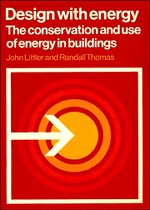Book contents
- Frontmatter
- Contents
- Units, symbols, abbreviations, conventions and conversion factors
- Preface
- 1 Energy and buildings
- 2 Site planning and analysis
- 3 Building design
- 4 Passive solar design
- 5 Active solar heating
- 6 Space heating and ventilation
- 7 Thermal storage
- 8 Wind energy
- 9 Water-supply systems
- 10 Waste disposal and utilization
- 11 Domestic-energy saving
- 12 Housing case studies
- 13 Non-domestic case studies
- Appendix 1 Weather data
- Appendix 2 Thermal performance
- Appendix 3 Interstitial condensation
- Index
7 - Thermal storage
Published online by Cambridge University Press: 03 February 2010
- Frontmatter
- Contents
- Units, symbols, abbreviations, conventions and conversion factors
- Preface
- 1 Energy and buildings
- 2 Site planning and analysis
- 3 Building design
- 4 Passive solar design
- 5 Active solar heating
- 6 Space heating and ventilation
- 7 Thermal storage
- 8 Wind energy
- 9 Water-supply systems
- 10 Waste disposal and utilization
- 11 Domestic-energy saving
- 12 Housing case studies
- 13 Non-domestic case studies
- Appendix 1 Weather data
- Appendix 2 Thermal performance
- Appendix 3 Interstitial condensation
- Index
Summary
Introduction
Storage has been discussed in a number of the preceding chapters and, notably, in conjunction with passive solar heating. Here we shall cover the topic more systematically but in some cases in less detail. Storage is often the key to the successful and economical use of solar or wind energy for space and hot-water heating. While it is possible, as we have seen in Chapter 3, to drastically reduce the space heating demand of buildings, the residual demand must either be met from a conventional source of fuel or from energy stored during a period of greater availability. Most buildings using solar or wind energy have been forced to limit storage capacity because of cost and employ a fossil-fuel back-up. Research projects, such as that of the Cambridge Autarkic House Project, are responsible for most of the (rare) designs which rely only on ambient sources of energy. It is nevertheless encouraging to know that even in the UK it is possible to provide in an average year 100% of the space and domestic hot-water heating requirements with solar energy alone.
The size of the store required for any application will depend on the energy demand, the source of energy and the selection of the storage medium. Because the cost per unit of storage falls as the size increases, more and more attention is being given to projects which involve large buildings or groups of dwellings. This in turn permits new equipment to be used more economically and novel means of storage to be examined.
- Type
- Chapter
- Information
- Design with EnergyThe Conservation and Use of Energy in Buildings, pp. 241 - 261Publisher: Cambridge University PressPrint publication year: 1984

